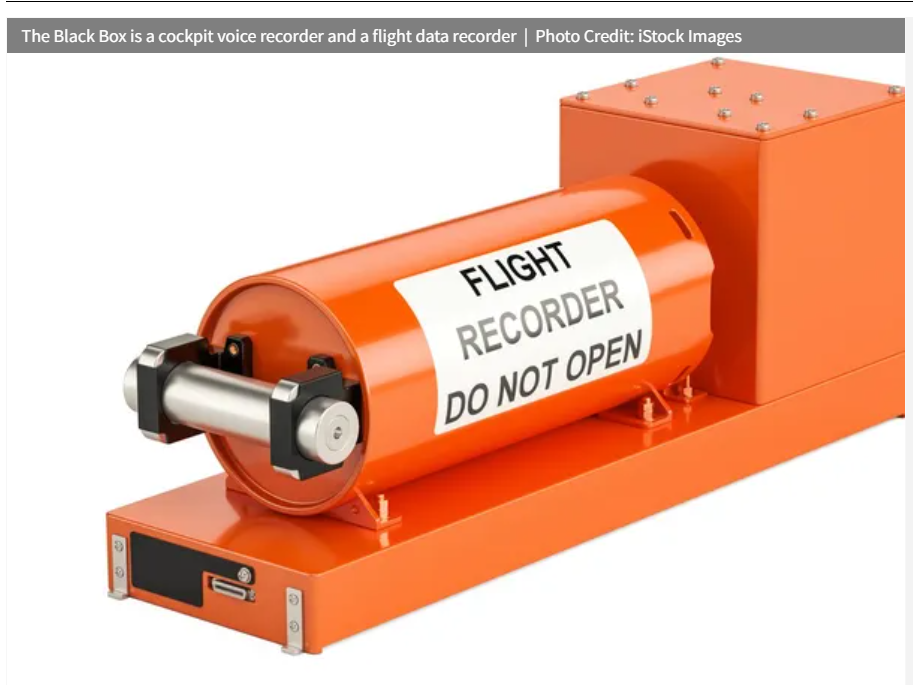When an aircraft accident occurs, one of the first items aviation investigators search for is the “black box.” Despite its dark-sounding name, this crucial flight instrument is bright orange and equipped with reflective tape to make it easy to find in the aftermath of a crash. The black box serves as the brain and memory of an airplane, storing critical data and recordings that help unravel the causes behind aviation accidents.

What Is a Black Box?
A black box in an airplane is actually composed of two separate devices:
- Flight Data Recorder (FDR)
- Cockpit Voice Recorder (CVR)
Together, these components provide comprehensive insights into what happened during the flight, including technical performance and human interaction in the cockpit.
1. Flight Data Recorder (FDR)
The FDR records up to 25 hours of technical flight information, including:
- Altitude
- Airspeed
- Heading
- Vertical acceleration
- Control inputs
- Engine settings
This data allows investigators to reconstruct the entire flight path, minute by minute.
2. Cockpit Voice Recorder (CVR)
The CVR captures the last two hours of audio inside the cockpit, including:
- Pilot conversations
- Interactions with air traffic control
- Audible alarms or engine sounds
- Background noises and radio chatter
This human side of the recording often reveals crew behavior, decision-making, and early signs of trouble.
How Are Black Boxes Built?
The black box is engineered to be virtually indestructible. It must survive the most extreme conditions, including:
- Crashes with massive G-forces
- High-temperature fires (up to 1100°C)
- Submersion under saltwater for 30+ days
- Piercing debris impact
It is made of high-grade stainless steel or titanium and features thick insulation and shock-absorbing materials. A battery-powered Underwater Locator Beacon (ULB) is also included, which emits sonar pings once submerged, making recovery possible even in deep oceans.
What Happens After a Crash?
Once a black box is found (often after days or weeks of searching), it is transported to an aviation safety lab. Technicians carefully extract and analyze the memory modules. The recovered data helps authorities:
- Reconstruct the aircraft’s last moments
- Identify mechanical failures
- Detect communication breakdowns
- Determine if weather, human error, or sabotage was involved
In many famous aviation cases, such as Air France Flight 447 or Malaysia Airlines Flight MH17, black box data was pivotal in understanding the sequence of events.
Why Is the Black Box Important?
Black boxes play a critical role in advancing aviation safety. They provide facts and prevent speculation. When paired with other data sources like radar or satellite telemetry, they help:
- Revise aircraft manufacturing standards
- Improve pilot training and protocols
- Strengthen communication systems
- Design better emergency responses
Each time data from a black box reveals a problem, it contributes to changes that save lives in future flights.
Conclusion
The black box is more than just a recorder—it’s a guardian of truth in the aviation world. It plays a pivotal role in unraveling the mysteries behind aircraft incidents and improving the overall safety of flight. Though we hope it’s never needed, when tragedy strikes, the black box stands as a silent witness that tells the story no one else can.
Frequently Asked Questions (FAQs)
Q1. Why is it called a “black box” if it’s orange?
The term “black box” is a legacy term from early engineering. In reality, it’s painted orange for high visibility during searches.
Q2. Where is the black box located in an airplane?
It’s typically placed at the rear of the aircraft because this area is more likely to survive a crash impact.
Q3. Can black boxes be hacked or tampered with?
Black boxes are highly secure and tamper-proof. While theoretically anything electronic can be hacked, they are protected by strict aviation security protocols.
Q4. How long can a black box record data?
- FDR: Usually stores the last 25 hours of flight data
- CVR: Stores the last 2 hours of cockpit audio
Q5. Are black boxes used in other industries?
Yes! Similar recorders are used in trains, ships, and even some cars for crash diagnostics and performance monitoring.
Q6. Has a black box ever not been recovered?
Yes, in rare cases. For instance, the black boxes from Malaysia Airlines Flight MH370 have never been recovered due to the aircraft’s disappearance over the Indian Ocean.
